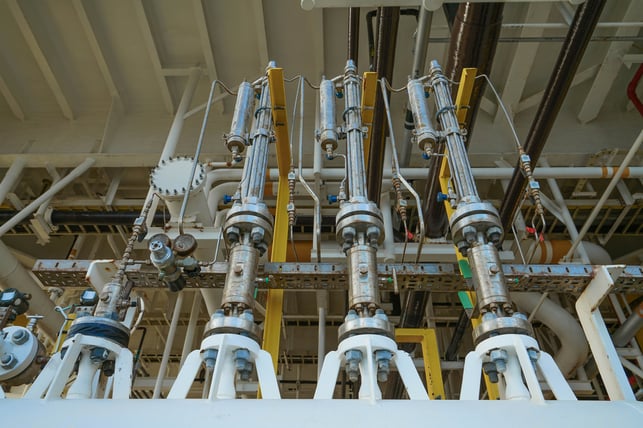Share this
How Industrial Gas Sampling Engineering Can Provide Budgetary Relief
by Morgan Zealear on 6/7/22 9:00 AM

Grab sampling is an important aspect of many fluid industries. Samples, when drawn leveraging best practices and within a safe environment, help industries meet their sampling goals with ease. A small mistake while designing or managing grab sampling components can lead to process anomalies—which often go undetected and call for costly reworks with the passage of time.
Understanding the nature of your sampling fluid and implementing custom designs are the keys to optimizing operational costs and improving yielding while keeping reworks to the minimum.
In this article, we discuss common grab sampling challenges and the role industrial gas sampling engineering plays in optimizing process costs.
Grab Sampling Challenges
Here are some of the most commonly seen grab sampling challenges.
Sample Handling
Failure to handle samples wisely can compromise their representativeness and the safety of the technician. For instance, trying to capture high-pressure liquid without a proper container can cause a spillover of the process fluid. Apart from liquid wastage, it may also violate essential HSE codes if the liquid is toxic in nature. Sometimes, samples are carried in an open bottle to the lab. If the sample has light components, they may start evaporating or fractionating in the absence of proper temperature and pressure.
The same is true for gas samples, except for the fact that their accidental release into the atmosphere may cost a refinery for exceeding the fugitive emission quota.
Needless to say, in the absence of proper grab sample guidance, such unfortunate situations would cost you in materials in the long run.
To eliminate these problems, facilities use fixed-volume liquid sampling. The system will capture a fixed volume press of liquid inside a pressure-rated container leaving 20% space free, enabling thermal expansion of the fluid. However, it is also important to select the right type of container for your samples.
Choice of Containers
Captured samples are prone to contamination under various circumstances. In the absence of fixed-volume, air-tight containers, the process fluid is prone to accidental breakage and contamination. Thus, it is imperative to select an ideal container.
There are two types of options available:
- Bottle containers
- Cylinder container
Here is a quick comparison between the two types.
|
Bottle Containers |
Cylinder Containers |
|
For non-pressure containing samples |
For pressure-containing samples |
|
Come with a self-sealing septum cap to avoid spillage or evaporation |
Have a seamless tube with smooth internal neck transition to avoid fluid traps in the path |
|
Low cost |
High cost |
Swagelok’s Grab Sampling Module (GSM), Grab Sample Cylinders (GSC), and Liquid-Only Sampling System (GSL) are designed to offer leak-proof containment with advanced industrial gas sampling engineering at the core.
To offer ease of use, Swagelok grab sample cylinders can be configured with optional handles and quick connect fittings. You can also add a bypass tube for purging.
Inaccurate System Response
It is important to accurately measure the time required for the sample to reach from the tap line to the analyzer, also known as the lag time. The lag time of a grab system is calculated by taking the volume and flow rate of all the associated components into account. The mode of calculation also changes depending on the sample type: liquid or gas.
Even a small calculation error repeated over a number of samples can cost you a huge loss in terms of waste of process fluid and time.
Ideally, a superior process control offers a time delay of not more than one minute. If it exceeds more than one minute for your existing sampling modules, you should look for optimizing delays in every possible system component, including the probe, sample transport, sample conditioning, and analyzer. Partnering with a team of local expert Field Engineers can help you analyze the cause faster.
Other Grab Sampling Deficiencies
Some problems may not directly influence cost but can certainly negatively impact sampling efficiency and operator safety. Two such common problems are improper labeling and unoptimized sampling locations.
Improper Labeling
Proper labeling is one of the fundamental aspects of industrial gas sampling engineering best practices. In the absence of precise labeling of grab sampling points and their associated components, new technicians, for example, may be susceptible to making mistakes while collecting samples. The collection of samples inside a container not dedicated to their chemical composition may compromise workplace safety and sample quality. Thus, it is important to create an asset register for each sample point, including tags for container type, fluid nature, different parts, flush time, frequency of sampling, etc.
Unoptimized Sampling Locations
The location of sample points greatly influences the operational efficiency of sampling. For instance, sample stations installed over a control valve get no flow when the valve is closed. Also, there is no predictable pressure drop when the valve is fully open. The best locations to ensure maximum drawing efficiency could be over a pump or on either end of a process line. Even choosing end-product lines would no longer require you to be concerned about valve position before sampling.
A fair knowledge about all such sampling mistakes and the working knowledge to avoid them is necessary to meet your sampling goals, safely and efficiently.
Get Local Support for Industrial Gas Sampling Engineering
Swagelok’s team of experts can evaluate your sample systems and assess your process against industry best practices. They track your system to offer time-sensitive information to address any potential issue before it’s too late. As a result, the operational cost and labor-intensive maintenance are reduced, and the system performs at its peak, ensuring maximum return on your investment.
To find out more about how Swagelok Northern California can help you incorporate industrial grab sampling engineering best practices for ensuring representative samples, contact our team today by calling 510-933-6200.

About Morgan Zealear | Product Engineer, Assembly Services
Morgan holds a Bachelor of Science in Mechanical Engineering from the University of California at Santa Barbara. He is certified in Section IX, Grab Sample Panel Configuration, and Mechanical Efficiency Program Specification (API 682), and he is well versed in B31.3 Process Piping Code. Before joining Swagelok Northern, he was a manufacturing engineer at Sierra Instruments, primarily focused on capillary thermal meters for the semiconductor industry (ASML).
Share this
- Archive (465)
- Assembly Services (207)
- About (100)
- Seal Support Systems (96)
- Best Practices (88)
- Training Services (74)
- Fittings (51)
- Semiconductor Applications (49)
- Hoses and Flexible Tubing (47)
- Regulators (44)
- Tubing (42)
- Grab Sampling Systems (32)
- Sampling Systems (32)
- Gas Systems (30)
- Services (30)
- Downloads (29)
- Valves (24)
- Application Support (18)
- Orbital Welding (17)
- Case Studies (13)
- Steam Systems (13)
- Frequently Asked Questions (12)
- Tools (12)
- Measurement Devices (7)
- Subsystems (6)
- Thermal Management (6)
- September 2023 (1)
- August 2023 (2)
- June 2023 (1)
- March 2023 (3)
- February 2023 (3)
- January 2023 (4)
- December 2022 (4)
- November 2022 (4)
- October 2022 (4)
- September 2022 (1)
- August 2022 (3)
- July 2022 (2)
- June 2022 (4)
- May 2022 (1)
- April 2022 (2)
- March 2022 (1)
- February 2022 (2)
- January 2022 (3)
- December 2021 (1)
- November 2021 (6)
- October 2021 (6)
- September 2021 (8)
- August 2021 (4)
- July 2021 (3)
- June 2021 (6)
- May 2021 (6)
- April 2021 (7)
- March 2021 (5)
- February 2021 (4)
- January 2021 (6)
- December 2020 (5)
- November 2020 (6)
- October 2020 (6)
- September 2020 (8)
- August 2020 (7)
- July 2020 (8)
- June 2020 (8)
- May 2020 (6)
- April 2020 (9)
- March 2020 (7)
- February 2020 (10)
- January 2020 (21)
- December 2019 (23)
- November 2019 (21)
- October 2019 (22)
- September 2019 (21)
- August 2019 (22)
- July 2019 (23)
- June 2019 (20)
- May 2019 (23)
- April 2019 (22)
- March 2019 (21)
- February 2019 (20)
- January 2019 (21)
- December 2018 (14)
- November 2018 (19)
- October 2018 (23)
- September 2018 (17)
- August 2018 (29)
- July 2018 (11)
- June 2018 (6)
- May 2018 (5)
- April 2018 (4)
- March 2018 (5)
- February 2018 (3)
- January 2018 (3)
- December 2017 (2)
- November 2017 (4)
- October 2017 (3)
- September 2017 (2)
- August 2017 (6)
- July 2017 (4)
- June 2017 (4)
- May 2017 (4)
- April 2017 (3)
- March 2017 (4)
- February 2017 (3)
- January 2017 (3)
- December 2016 (3)
- November 2016 (3)
- October 2016 (3)
- September 2016 (5)
- August 2016 (5)
- July 2016 (4)
- June 2016 (5)
- May 2016 (3)
- April 2016 (4)
- March 2016 (5)
- February 2016 (11)
- January 2016 (1)
- December 2015 (3)
- November 2015 (4)
- October 2015 (3)
- September 2015 (4)
- August 2015 (4)
- July 2015 (8)
- June 2015 (5)
- May 2015 (3)
- April 2015 (4)
- March 2015 (4)
- February 2015 (3)
- January 2015 (4)
- December 2014 (2)
- November 2014 (3)
- October 2014 (4)
- September 2014 (4)
- August 2014 (4)
- July 2014 (5)
- June 2014 (4)
- May 2014 (4)
- April 2014 (5)
- March 2014 (4)
- February 2014 (3)
- January 2014 (4)
- December 2013 (5)
- November 2013 (3)
- October 2013 (4)
- September 2013 (3)
- August 2013 (5)
- July 2013 (5)
- June 2013 (5)
- May 2013 (3)
- April 2013 (6)
- March 2013 (4)
- February 2013 (4)
- January 2013 (8)
- December 2012 (4)
- November 2012 (6)
- October 2012 (6)
- September 2012 (4)
- August 2012 (4)
- July 2012 (4)
- June 2012 (4)

.webp?width=210&height=70&name=StickyLogo%20(5).webp)